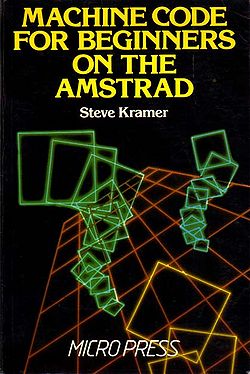Difference between revisions of "Machine Code for Beginners on the Amstrad"
From CPCWiki - THE Amstrad CPC encyclopedia!
Cpcmaniaco (Talk | contribs) (→Information) |
Cpcmaniaco (Talk | contribs) |
||
| Line 5: | Line 5: | ||
{|{{Prettytable|width: 700px; font-size: 2em;}} | {|{{Prettytable|width: 700px; font-size: 2em;}} | ||
| − | |Title:|| Machine Code for Beginners on the Amstrad | + | |Title:|| '''Machine Code for Beginners on the Amstrad''' |
|- | |- | ||
|Authors:|| Steve Kramer | |Authors:|| Steve Kramer | ||
| Line 22: | Line 22: | ||
<pre> | <pre> | ||
| − | |||
| − | |||
| − | |||
| − | |||
| − | |||
| − | |||
| − | |||
| − | |||
| − | |||
| − | |||
| − | |||
| − | |||
| − | |||
| − | |||
| − | |||
| − | Appendices | + | 01. Introduction. |
| + | 02. What is machine code and why use it? | ||
| + | 03. First concepts. | ||
| + | 04. Flow charts. | ||
| + | 05. Simple machine code instructions. | ||
| + | 06. Simple maths. | ||
| + | 07. Flags, conditions and decision making. | ||
| + | 08. Logical operations. | ||
| + | 09. Using the machine stack. | ||
| + | 10. Using instructions that work on a single bit. | ||
| + | 11. Rotates and shifts, multiplication and division. | ||
| + | 12. Automated moves and searches. | ||
| + | 13. Communicating with the outside world. | ||
| + | 14. Other instructions, indexed addressing. | ||
| + | 15. Programming hints, and using the firmware. | ||
| + | |||
| + | Appendices. | ||
| + | |||
</pre> | </pre> | ||
| − | [[Category:Books]] | + | [[Category:Books]] [[Category:Book cover]] |
Revision as of 15:11, 30 June 2010
Information
| Title: | Machine Code for Beginners on the Amstrad |
| Authors: | Steve Kramer |
| Publiser: | Micro Press |
| Year: | 1984 |
| Pages: | 189 |
| ISBN: | 0-7447-0025-6 |
Contents
01. Introduction. 02. What is machine code and why use it? 03. First concepts. 04. Flow charts. 05. Simple machine code instructions. 06. Simple maths. 07. Flags, conditions and decision making. 08. Logical operations. 09. Using the machine stack. 10. Using instructions that work on a single bit. 11. Rotates and shifts, multiplication and division. 12. Automated moves and searches. 13. Communicating with the outside world. 14. Other instructions, indexed addressing. 15. Programming hints, and using the firmware. Appendices.
